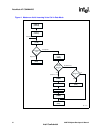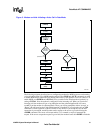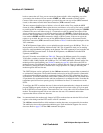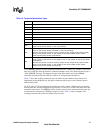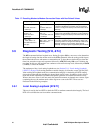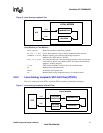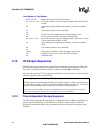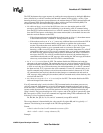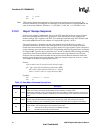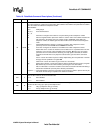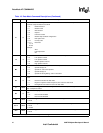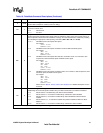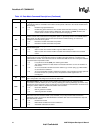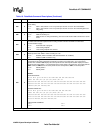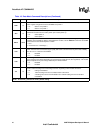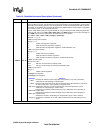
40 536EX Chipset Developer’s Manual
Intel Confidential
Data Mode AT COMMANDS
DTE: +++ AT<CR>
DCE: OK
Note: TIES requires that the three-character escape sequence be contiguous and not repeated. The
character immediately preceding the first character of the three-character sequence cannot be the
same as the escape character. Therefore, ‘
+++ AT<CR>’ is valid, but ‘++++ AT<CR>’ is not.
3.10.2 Hayes* Escape Sequence
In this escape sequence, implemented with +++, the DTE sends the modem an escape character
three times, preceded and followed by guard times. Upon detecting the escape sequence, the
modem sends an ‘OK’ response to the DTE. To re-enter the online data state, the DTE then sends
the modem ATO followed by the contents of S-register S3 (typically a <CR>).
The escape character is determined by the value stored in S-register S2 and is typically a ‘
+’
character. Guard times are silence times when the DTE does not send any data to the modem.
Guard times ensure that the modem does not falsely detect an escape sequence if three consecutive
escape characters are received from the DTE. The preceding and following guard times are defined
in S-register S12. Typically, these guard times are 1 second. In addition to the preceding and ending
guard times, there are inter-character time-outs between each escape character sent. The inter-
character time-outs define the maximum amount of time allowed between characters before the
modem ignores the previous escape characters. This inter-character delay time is set to 1 second.
An example of the Hayes Escape Sequence follows:
Format:
<gt1><char1><tm 2><char2><tm3><char3><gt4>
gt1 = gt4
≥ preceding and following guard times (S12)
tm2 = tm3
≤ inter-character time-out (= 1 second)
char1 = char2 = char3 = escape character (S2)
Example:
DTE: 1 second +++ 1 second
DCE: OK
Table 18. Data Mode Command Descriptions
Command Default Description
A/ none
Repeat Last Command: This command re-executes the last AT command string stored in the command
buffer. A/ is the only command not preceded by AT and ended by a carriage return.
Sending any character (such as a carriage return) after A/ and before a modem response is sent to the
DTE causes the modem to abort the remainder of the command string in the modem internal command
buffer.
A none
Answer Command: This command causes the modem to immediately go off-hook and initiate an
answer mode handshake without waiting for an incoming ring signal. This command is useful for
manually answering a call or establishing a back-to-back connection with an originate-mode modem.
Cn 1
Carrier Control Option: This command is reserved for selecting between controlled carrier or constant
carrier modes. This modem supports only constant carrier mode.
n = 0 Transmit carrier always off (returns an ERROR message)
n = 1* Normal transmit carrier (constant carrier)
NOTE: An asterisk (*) denotes the factory-default setting.



